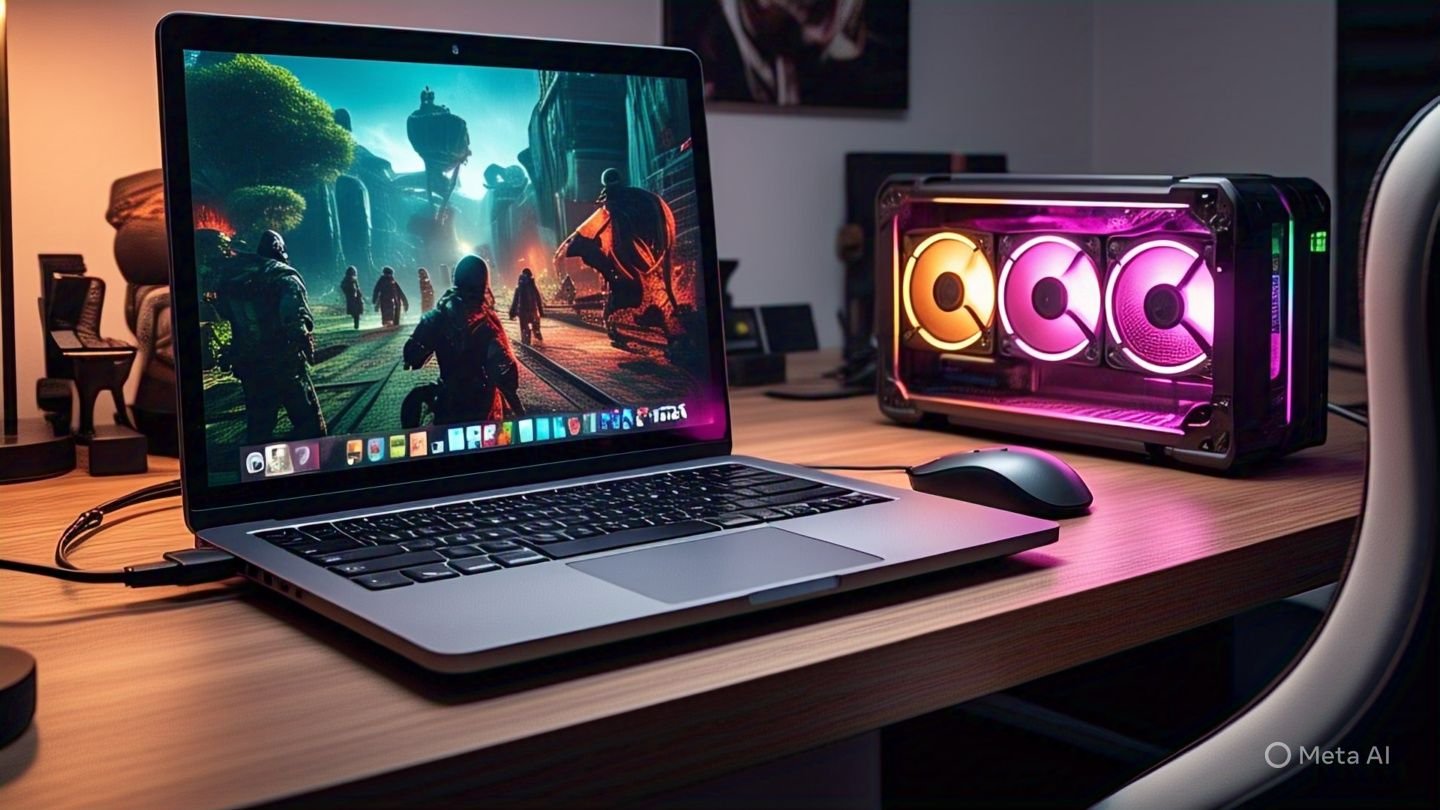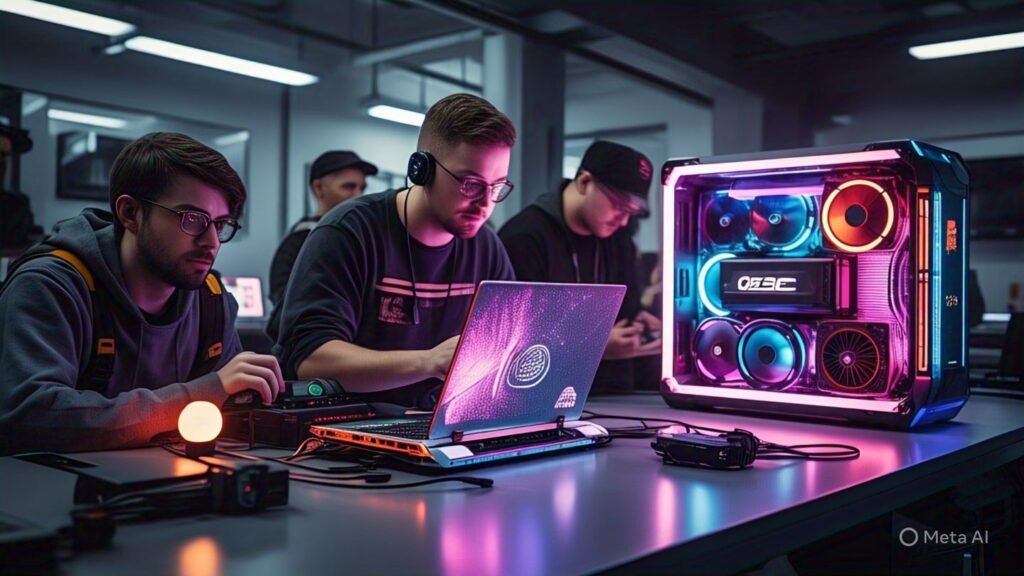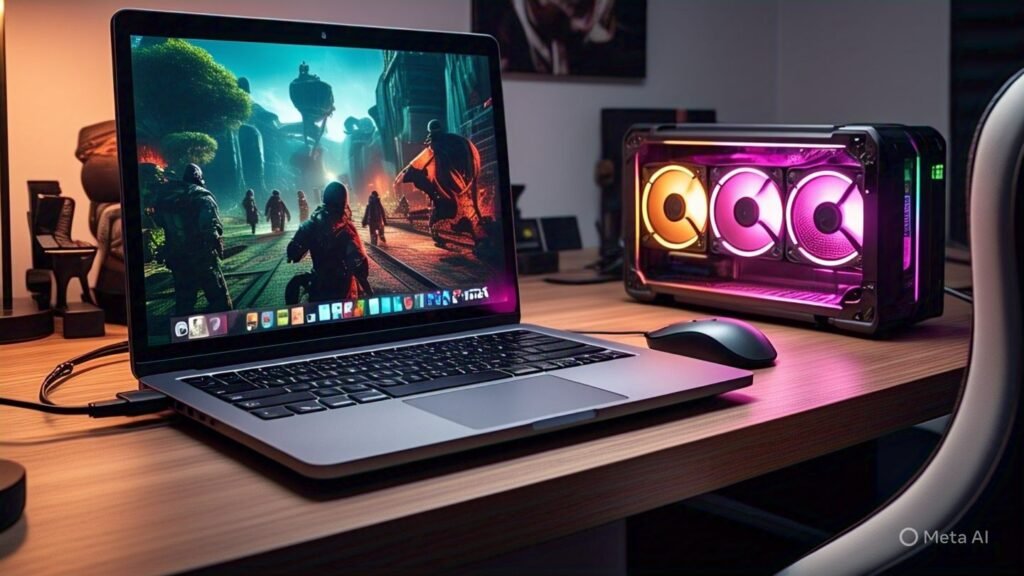Introduction to External GPUs
In recent years, the demand for high-performance gaming from laptops has surged, yet many portable computers struggle to deliver the graphics capabilities needed for an optimal gaming experience. This gap is where external GPUs, commonly referred to as eGPUs, come into play. An external GPU is a dedicated graphics processing unit that is housed outside the laptop, allowing for significantly improved graphical output. By connecting via Thunderbolt or USB-C, these devices enable users to tap into high-end graphic potential without being limited by the internal hardware of their gaming laptops.
The importance of eGPUs for laptop gamers cannot be overstated. They allow for enhanced graphics performance and provide depth to a laptop’s capabilities, transforming it into a powerful gaming machine. Gamers can expect higher frame rates, better visual fidelity, and the capability to run the latest titles at increased settings. Furthermore, eGPUs facilitate upgrades; as the technology evolves, gamers have the option to update their external graphics solutions without necessitating a complete laptop replacement.
This adaptability has contributed to the rising popularity of eGPUs among gamers who need a portable system but refuse to compromise on performance. As graphics-intensive games continue to advance, many gamers seek out eGPUs as essential accessories for their gaming laptops. By incorporating an external GPU into their rigs, users can significantly improve not only gaming performance but also other graphic-intensive tasks such as video editing and 3D modeling, making these devices versatile tools. The growing ecosystem of eGPU options indicates that their relevance will only increase in the gaming community, cementing their position as a necessary component of modern portable gaming solutions.
Key Factors to Consider When Choosing an eGPU

When selecting an external GPU (eGPU) for your gaming laptop, several critical factors warrant your attention to ensure optimal performance and compatibility. The first aspect to consider is compatibility; not all laptops support eGPUs, so it is crucial to verify that your specific model can interface with an external graphics card. Most modern laptops utilize Thunderbolt 3 or USB-C ports for connectivity, offering high bandwidth necessary for gaming performance. An external GPU that is not compatible with your laptop’s port will not deliver the intended benefits.
Next, performance benchmarks play a significant role in your decision-making process. It is advisable to research various eGPUs to understand how they perform in real-world gaming scenarios. Look for reviews and comparisons that detail frame rates and resolutions across a variety of titles you intend to play. This information will help you determine whether the eGPU can meet your gaming expectations.
Another vital consideration is the type of games you play. Different games demand different levels of graphical power, and some eGPUs are better suited for specific genres. For instance, fast-paced shooters or visually intensive RPGs often require more robust processing capabilities than less demanding puzzle games. Evaluating your gaming preferences can guide you in selecting an external GPU that aligns with your needs.
Budget constraints are an inevitable factor that influences purchasing decisions. eGPUs come with varying price tags, and establishing a clear budget upfront can assist in narrowing down your choices. Additionally, consider the form factor of the eGPU. If you value portability, you may prefer a smaller, more compact model over a larger one. Finally, brand reputation matters; choose well-established brands known for reliability and customer support. This approach ensures that your chosen eGPU will provide long-lasting performance and satisfaction.
Top eGPUs for Gaming Laptops in 2023
As gaming technology continues to advance, external Graphics Processing Units (eGPUs) have become essential for enhancing the performance of gaming laptops. In 2023, several standout eGPUs have emerged, each offering unique specifications and features tailored to varying gaming needs.
One highly regarded model is the Razer Core X Chroma. It’s compatible with both Windows and macOS, making it versatile for different user environments. With support for powerful graphics cards such as the NVIDIA GeForce RTX 3080, gamers can achieve high frame rates and stunning visuals in demanding titles. The Razer Core X Chroma boasts a robust build and customizable RGB lighting, appealing to those who value aesthetics as much as performance. However, its price point may be steep for budget-conscious gamers.
Next, the ASUS ROG XG Station Pro deserves mention. This eGPU not only provides solid graphics performance but also integrates a sleek design that fits well within gaming setups. It supports various GPUs, up to the RTX 3090, and leverages Thunderbolt 3 technology for fast data transfer and low latency. Gamers looking for an efficient solution should consider this option, although it also comes with a premium price tag.
For those seeking affordability without compromising significantly on performance, the Gigabyte AORUS GTX 画 stands out. It offers an effective balance of specs and pricing, specifically formulated for gamers with a diverse game library. Its compact design enhances portability, making it an excellent choice for on-the-go gaming. Yet, it may not support the highest-end graphics cards available on the market.
Many eGPUs excel in specific tasks, catering to various player preferences, from competitive online play to immersive AAA gaming experiences. Overall, the leading eGPUs of 2023 underscore the evolving landscape of portable gaming and the increasing importance of external solutions for enhanced performance.
Installation and Setup of External GPUs
Installing and setting up an external GPU (eGPU) with a gaming laptop can significantly enhance the device’s graphics performance, enabling a superior gaming experience. The process begins with ensuring compatibility between your laptop and the eGPU. Verify that your laptop has the required Thunderbolt 3 port, which is crucial for connecting the eGPU. Additionally, confirm that your gaming laptop supports eGPUs. If in doubt, consult the manufacturer’s specifications or support documents.
Once compatibility is confirmed, the next step is to gather all necessary components. This typically includes the eGPU enclosure, a compatible graphics card, power supply, and the necessary cables. Most eGPU enclosures require a PCIe graphics card to be installed inside. Carefully open the eGPU enclosure and insert the graphics card into the PCIe slot, securing it adequately as per the manufacturer’s instructions.
After installing the graphics card, connect the eGPU enclosure to your gaming laptop using the Thunderbolt 3 cable. It’s advisable to plug in the eGPU’s power supply before establishing the connection to your laptop. Once connected, power on the eGPU and the laptop. Your operating system should automatically detect the new hardware. However, to ensure optimal performance, it’s essential to download and install the latest drivers for the graphics card from the manufacturer’s website.
In addition to the drivers, some systems may require specific software to manage the eGPU. Upon installation of the required software and drivers, reboot your gaming laptop to finalize the setup. After rebooting, users may want to adjust graphics settings in their games to take full advantage of the improved capabilities provided by the eGPU. Ensuring that your laptop is set to operate with the eGPU for graphics processing will yield the best results during gaming sessions.
Performance Comparison of External GPUs
The realm of external GPUs (eGPUs) has gained significant traction among gaming enthusiasts seeking enhanced performance from their laptops. This section will delve into a performance comparison of various eGPUs, focusing on their capabilities as demonstrated through benchmarks and gaming tests. By analyzing these metrics, readers will better grasp how each model performs under diverse conditions, ultimately aiding in their decision-making process.
To assess the performance of different eGPUs, we conducted a series of benchmarks utilizing several commonly referenced tools, such as 3DMark and Unigine Heaven. These benchmarks measure the graphic performance and overall rendering capabilities of the eGPUs. The results revealed that high-end eGPU models typically achieve superior frame rates, even at elevated resolutions. For instance, the Razer Core X and the ASUS ROG XG Station 2 delivered exceptional results, showcasing high frame rates in demanding games at 1440p resolution, consistently exceeding 60 FPS.

Moreover, gaming performance was tested across multiple titles, including popular games like Cyberpunk 2077 and Call of Duty: Warzone. Here, we noted that the performance of eGPUs can differ significantly based on their GPU models. The NVIDIA GeForce RTX 3080 showcased remarkable performance, allowing smooth gameplay at ultra settings without sacrificing visual fidelity. Conversely, models equipped with older GPUs, such as the GTX 1660 Ti, struggled to maintain consistent frame rates when pushed to similar settings.
Another factor influencing eGPU performance is thermal management. Lower temperatures have been associated with consistent performance, as tested models with better cooling solutions, such as the AORUS Gaming Box, frequently outperformed others under extended loads. Thus, prospective buyers should consider cooling capabilities alongside raw performance when evaluating different external GPUs.
Potential Issues and Troubleshooting with eGPUs
As gaming laptops become more adaptable, the use of external GPU (eGPU) solutions introduces numerous opportunities for enhanced graphics performance. However, users may also encounter various challenges that can hinder their gaming experience. Understanding potential issues related to eGPU use is crucial for effective troubleshooting and ensuring optimal performance.
One common problem is compatibility errors. Not all laptops support eGPUs, and users may find that their devices lack the necessary Thunderbolt 3 or USB-C ports required for connectivity. It is essential to verify that the laptop’s operating system and BIOS settings are updated, as these factors can significantly influence compatibility. Before purchasing an eGPU, users should always check the manufacturer’s specifications and forums for confirmed support.
Performance bottlenecks can also arise from various factors, including limitations in the laptop’s CPU or internal memory. While an eGPU may provide significant enhancements in graphical performance, it cannot compensate for other hardware limitations. Users should monitor their system performance using benchmarking tools to identify any discrepancies between expected and actual performance outcomes.
Additionally, driver conflicts frequently occur when eGPUs are installed. A robust gaming performance requires the installation of appropriate drivers, which can sometimes lead to issues if not properly managed. Regularly updating drivers and ensuring that the eGPU and laptop components are running compatible versions is recommended. Users should also consider reinstalling drivers or utilizing software utilities specifically designed to manage and troubleshoot driver issues.
Finally, users may experience power-related problems. Some eGPUs require their own power supply, and inadequate power delivery can lead to suboptimal performance. To resolve this, it is vital to ensure the eGPU is connected to a sufficient power source and that the laptop supports the required power standards.
Future Trends in External GPU Technology
The landscape of external GPUs (eGPUs) is rapidly evolving, driven by advancements in technology and the increasing demand for enhanced gaming experiences on laptops. One of the primary trends shaping the future of eGPU technology is the introduction of improved connectivity options, particularly with the advent of Thunderbolt 4. This new standard offers significantly higher bandwidth, allowing for faster data transfer rates between the laptop and the eGPU, thereby reducing latency and enhancing overall performance. Gamers can expect smoother frame rates and improved graphical fidelity when using eGPUs that leverage this technology.
An additional trend on the horizon is the potential for transformative changes in hardware performance. As manufacturers develop more powerful graphics cards, the capability of eGPUs will improve accordingly. These innovations may come in the form of higher wattage support, enabling more robust cooling solutions, and ultimately, more powerful GPUs tailored for eGPU usage. Furthermore, robust integration of artificial intelligence (AI) and machine learning could lead to smarter resource management in eGPUs, optimizing performance on the fly based on the demands of the games being played.
Another significant trend is the focus on enhancing the user experience through innovative design and functionalities. There is a growing emphasis on making eGPUs more portable and user-friendly, as gaming on the go becomes increasingly popular. Features such as customizable RGB lighting, plug-and-play setups, and compact designs can attract more users seeking versatility without compromising on performance. Additionally, cloud gaming technology is beginning to integrate with eGPU setups, potentially offering users seamless access to high-end gaming experiences without solely relying on local hardware capabilities.
In this ever-evolving landscape, embracing these trends will be essential for gamers looking to maximize their gaming laptops’ potential, ensuring they remain competitive and fully equipped for the future of gaming.
Real-Life User Experiences and Reviews

The world of external graphics processing units (eGPUs) has grown robust, leading to a significant number of gamers sharing their experiences. Many users report that the addition of an external GPU dramatically enhances their gaming performance, often awakening previously underutilized potential in their laptops. A common sentiment among users is the ease of installation and setup, one of the critical advantages of using eGPUs. Several gamers noted that connecting an external GPU through Thunderbolt 3 is not only straightforward but also significantly reduces the time required to enjoy high-quality graphics in demanding games.
Performance tests frequently shared within the gaming community reveal that popular eGPU models, such as the Razer Core X and the Akitio Node, consistently offer significant frame rate improvements across various titles. Users have commented on the smooth gameplay and higher resolutions achievable with these setups. For instance, a gamer who switched to an eGPU reported a leap from 30 frames per second (FPS) to 100 FPS in demanding games like Cyberpunk 2077, illustrating the profound impact that these devices can have on gameplay quality.
Satisfaction ratings also vary but tend to skew positively; survey data indicates that a majority of gamers express high satisfaction with their eGPU investments. However, some users have voiced concerns regarding thermal management and noise levels, particularly in compact setups. Others have highlighted issues with compatibility, especially with older laptop models, emphasizing the need to verify specifications before making a purchase.
Despite the few detractors, the general consensus remains that eGPUs bridge the gap between powerful desktop graphics capabilities and the convenience of laptops, making them an attractive option for gamers who desire mobility without sacrificing performance.
Conclusion and Final Thoughts
As we conclude our exploration of the best external GPUs (eGPUs) for gaming laptops in 2023, it is vital to recap the essential factors that influence your choice. The rise of external graphics cards has revolutionized the gaming experience, enabling laptop users to tap into the power typically reserved for desktop systems. When selecting the right external GPU, one must consider compatibility, performance benchmarks, and future-proofing capabilities. These critical aspects ensure that your investment supports a wide range of demanding games and applications seamlessly.
Throughout this guide, we highlighted several excellent eGPU options available in the current market. These include models equipped with the latest GPUs, providing substantial performance enhancements over integrated graphics. The importance of a well-suited eGPU cannot be overstated; it profoundly impacts load times, graphical fidelity, and overall gameplay experience. Moreover, as technology continues to evolve, staying informed about the latest advancements in external GPUs is crucial for any dedicated gamer. Keeping an eye on upcoming releases and potential upgrades ensures that your gaming setup remains optimal and relevant.
In addition to the standout models discussed, users should take their unique gaming preferences and requirements into account. Whether playing graphically intensive titles or more casual games, selecting the appropriate external GPU tailored to your needs will result in a more satisfactory experience. Therefore, we encourage you to weigh your options carefully, prioritize the features most relevant to you, and embrace the advancements that eGPU technology brings to the table. Doing so will ensure that you are well-prepared to enjoy the immersive and high-quality gaming experiences that await.


